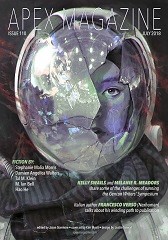“The Chariots, the Horsemen” by Stephanie Malia Morris
Reviewed by Mike Wyant, Jr.
Stephanie Malia Morris‘s “The Chariots, the Horsemen” is, well, quite beautiful. We first encounter our narrator as she “ascends”, or flies, for the first time during a church service. While you might expect this to be a welcomed miracle, it isn’t. Her grandfather forces her to the ground, chains her there, and treats her like some grotesque creature worthy of ridicule and spewed vitriol. As the story progresses, we start to see that he’s restricting her potential because of his own insecurity. It’s an allegorical tale of finding worth and beauty in yourself, even when those closest to you try and stifle the things that make you special. Morris ends “The Chariots, the Horsemen” with a victorious dash that brings everything to a satisfying conclusion.
“When You’re Ready” by M. Ian Bell takes you into the mind of an unnamed narrator as he crafts a simulated consciousness (simulant) through childhood, adolescence, and, finally, adulthood. The story truly comes to a head as the simulant meets his first real love. The narration is almost… sterile in its style through the first half of the story, as if it’s truly the scientific journal of this unnamed man. However, the further we get into the simulant’s life, the more that objective take breaks down and bleeds emotion, just as the simulant himself does.
The style and form of the story is just beautiful. The more I consider it, the more I realize how well everything is tied together, from narration, to plotting, to the infrequent dialog with Diane. It’s a wonderful piece.
“Kerouac’s Renascence” by Tal M. Klein follows Kerouac Jones on his journey to kill himself so he won’t die a slow death from Huntington’s disease. Written in an epistolary style, “Kerouac’s Renascence” feels more at home in a literary fiction collection than science fiction. The story is emotive and layered pleasantly throughout Kerouac’s time in Japan and most of the trip on the cruise ship, the Empress Polaris.
However, I found the ending to be rather unfulfilling as the speculative element, a bubble of space-time triggered by a volcano that results in the ship arriving in San Francisco twenty years later, seemed rather tacked onto the story. If I’m honest, I would’ve found the expected ending—Kerouac’s arrival in San Francisco and his subsequent death—much more fulfilling.
In short, it’s a well-written and thought-provoking piece, but the ending left much to be desired.
The dystopian world crafted by Hao He in “All Clear!” is complex and interesting. The cultural and technological layout and description is fascinating and very complete, from the anti-grav units keeping an aging skyscraper in the air, to the biological adaptations of the latest generation that allow them a sort of telepathy.
The story itself follows Zhang Dong as a group of fanatics and stoners break into his farming community. By allying with members of this newer generation, he is able to stop a coup and bring relative peace back to his home.
While I really enjoyed the world-building, I wasn’t as intrigued by the story and conflicts. Quite a few pieces were predictable—Zhang’s son, his friend Liang, and the conflict with his father—and it lessened the impact of the story for me. Overall, it’s worth reading for the world, but don’t expect too much in complex plot movement.
Mike Wyant, Jr. is an ex-IT guy, who has finally committed to a writing life out in the Middle of Nowhere, New York.
 Apex #110, July 2018
Apex #110, July 2018